Selected Properties of the Surface Layer of C45 Steel Samples after Slide Burnishing
Abstract
:1. Introduction
2. Materials and Methods
- r—radius of the ringed sample;
- x—distance from the edge of the perpendicular micro-section;
- a—distance from the edge of the angled micro-section.
- σ—surface tension;
- γ—surface free energy;
- S—unit of area of a given body.
- σSV—surface tension in the solid-gas interface;
- σSL—surface tension in the solid-liquid interface;
- σLV—surface tension in the liquid-gas interface;
- ΘV—equilibrium contact angle.
3. Results and Discussion
3.1. Surface Topography and Material Bearing Curve
3.2. 2D Surface Roughness
3.3. Microhardness
3.4. Surface Free Energy (SFE) and Drop Shape
4. Conclusions and Summary
- The effects of slide burnishing depend on the type of medium in which the process is carried out. As a result of the employed treatment, all studied properties of the surface layer changed.
- After slide burnishing of elements made of C45 unalloyed steel using different machining fluids, the surface roughness parameters Ra and Rt decreased as expected. The surface roughness parameter Ra decreased by more than eight times, and Rt by more than five times compared to the value after grinding. Regarding the Abbott–Firestone curve parameters, the effect of slide burnishing was more complex. The reduced peak height decreased from 79% to 82%, while the depth of the surface roughness core decreased from 84% to 88% in relation to the value after grinding. Favourable changes can contribute to improving the functionality of these surfaces.
- An unfavourable phenomenon observed after slide burnishing was a decrease in the Rvk parameter—its value reduced from 45% to 60%, which indicates a probable decrease in the retention capacity of the lubricant in the mating friction pair.
- After slide burnishing, the 3D parameters of the surface roughness also changed: the topography changed (micro-irregularities were more deformed and irregular), the angle of inclination of the Abbott–Firestone curve also changed (the curve was more flattened), and the material ratio of Smr increased for the cut-off levels of c = 40% and c = 60%.The increase in the material ratio allows us to conclude that the materials are resistant to abrasive wear.
- In terms of abrasive wear resistance, the greatest changes in 2D and 3D surface roughness, surface topography, and Abbott–Firestone curve were obtained when the slide-burnishing process was conducted using oil+PMM+MoS2 as a machining liquid.
- The addition of PMM and MoS2 to the oil caused an about 25% increase in microhardness compared to the ground sample. The changes in microhardness after slide burnishing for the “richest” machining centre reached up to 20 μm.
- After slide burnishing, similar values of surface free energy or a slight increase in the surface free energy were obtained, when compared to the values after grinding.
Author Contributions
Funding
Institutional Review Board Statement
Informed Consent Statement
Data Availability Statement
Conflicts of Interest
References
- Silva-Alvarez, D.F.; Marquez-Herrera, A.; Saldana-Robles, A.; Zapata-Torres, M.; Mis-Fernandez, R.; Pena-Chapa, J.L.; Moreno-Palmerin, J.; Hernandez-Rodiguez, E. Improving the surface integrity of CoCrMo alloy by the ball burnishing technique. J. Mater. Res. Technol. 2020, 9, 759–7601. [Google Scholar] [CrossRef]
- Saldaña-Robles, A.; Plascencia-Mora, H.; Aguilera-Gómez, E.; Saldaña-Robles, A.; Marquez-Herrera, A.; Diosdado-Dela Peña, J.A. Influence of ball-burnishing on roughness, hardness and corrosion resistance of AISI1045 steel. Surf. Coat. Technol. 2018, 339, 191–198. [Google Scholar] [CrossRef]
- Maximov, J.T.; Duncheva, G.V.; Anchev, A.P.; Ichkova, M.D. Slide burnishing—Review and prospects. Int. J. Adv. Manuf. Technol. 2019, 104, 785–801. [Google Scholar] [CrossRef]
- Das, T.; Erdogan, A.; Kursuncu, B.; Maleki, E.; Unal, O. Effect of severe vibratory peening on microstructural and tribological properties of hot rolled AISI 1020 mild steel. Surf. Coat. Technol. 2020, 403, 126383. [Google Scholar] [CrossRef]
- Azhari, A.; Sulaiman, S.; Prasada Rao, A.K. A review on the application of peening processes for surface treatment. IOP Conf. Ser. Mater. Sci. Eng. 2016, 114, 012002. [Google Scholar] [CrossRef]
- Uhlmann, E.; Hoyer, A. Surface Finishing of Zirconium Dioxide with Abrasive Brushing Tools. Machines 2020, 8, 89. [Google Scholar] [CrossRef]
- Kulisz, M.; Zagórski, I.; Matuszak, J.; Kłonica, M. Properties of the surface layer after trochoidal milling and brushing: Experimental and artificial neural network simulation. Appl. Sci. 2020, 10, 75. [Google Scholar] [CrossRef]
- Świrad, S.; Wydrzynski, D.; Nieslony, P.; Krolczyk, G.M. Influence of hydrostatic burnishing strategy on the surface topography of martensitic steel. Measurment 2019, 138, 590–601. [Google Scholar] [CrossRef]
- Sartkulvanich, P.; Altan, T.; Jasso, F.; Rodriguez, C. Finite element modeling of hard roller burnishing: An analysis on the effects of process parameters up on surface finish and residual stresses. J. Manuf. Sci. Eng. 2007, 129, 705–716. [Google Scholar] [CrossRef]
- Tugay, I.O.; Hosseinzadeh, A.; Yapici, G.G. Hardness and wear resistance of roller burnished 316L stainless steel. Mater. Today Proc. 2021, 47, 2405–2409. [Google Scholar] [CrossRef]
- Hua, Y.; Liu, Z.; Wang, B.; Hou, X. Surface modification through combination of finish turning with low plastity burnishing and its effect on fatigue performance for Inconel 718. Surf. Coat. Technol. 2019, 375, 508–517. [Google Scholar] [CrossRef]
- Aviles, A.; Aviles, R.; Albizuri, J.; Pallares-Santasmartas, L.; Rodriguez, A. Effect of shot peening and low plasticity burnishing on the high-cycle fatigue strength of DIN 34CrNiMo6 alloy steel. Int. J. Fatigue 2019, 119, 338–354. [Google Scholar] [CrossRef]
- Kalisz, J.; Żak, K.; Wojciechowski, S.; Gupta, M.K.; Krolczyk, G.M. Technological and tribological aspects of milling—Burnishing process of complex surfaces. Tribol. Int. 2021, 155, 106770. [Google Scholar] [CrossRef]
- Nie, L.; Wu, Y.; Gong, H.; Chen, D.; Guo, X. Effect of shot peening on redistribution of residual stress field in friction stir welding of 2219 aluminum alloy. Materials 2020, 13, 3169. [Google Scholar] [CrossRef] [PubMed]
- Kubit, A.; Bucior, M.; Zielecki, W.; Stachowicz, F. The impact of heat treatment and shot peening on the fatigue strength of 51CrV4 steel. Procedia Struct. Integr. 2016, 2, 3330–3336. [Google Scholar] [CrossRef]
- Zhang, X.; Hansen, N.; Gao, Y.; Huang, X. Hall–Petchand dislocation strengthening in graded nanostructured steel. Acta Mater. 2012, 60, 5933–5943. [Google Scholar] [CrossRef]
- Walczak, M. Surface Characteristics and Wear Resistance of 316L Stainless Steel after Different Shot Peening Parameters. Adv. Sci. Technol. Res. J. 2023, 17, 124–132. [Google Scholar] [CrossRef] [PubMed]
- Walczak, M.; Szala, M. Effect of shot peening on the surface properties, corrosion and wear performance of 17-4PH steel produced by DMLS additive manufacturing. Arch. Civ. Mech. Eng. 2021, 21, 157. [Google Scholar] [CrossRef]
- Maleki, E.; Unal, O. Roles of surface coverage increase and re-peening on properties of AISI 1045 carbon steel in conventional and severe shot peening processes. Surf Interfaces 2018, 11, 82–90. [Google Scholar] [CrossRef]
- Klotz, T.; Delbergue, D.; Bocher, P.; Lévesque, M.; Brochu, M. Surface characteristics and fatigue behavior of shot peened Inconel 718. Int. J. Fatigue 2018, 110, 10–21. [Google Scholar] [CrossRef]
- Zhan, K.; Wu, Y.; Li, J.; Zhao, B.; Yan, Y.; Xie, L.; Ji, V. Investigation on surface layer characteristics of shot peened graphene reinforced Al composite by X-ray diffraction method. Appl. Surf. Sci. 2018, 435, 1257–1264. [Google Scholar] [CrossRef]
- Skoczylas, A.; Zaleski, K.; Matuszak, J.; Ciecieląg, K.; Zaleski, R.; Gorgol, M. Influence of Slide Burnishing Parameters on theSurface Layer Properties of Stainless Steel and Mean Positron Lifetime. Materials 2022, 15, 8131. [Google Scholar] [CrossRef] [PubMed]
- Kecik, K.; Ciecielag, K.; Zaleski, K. Damage detection by recurrence and entropy methods on the basis of time series measured during composite milling. Int. J. Adv. Manuf. Technol. 2020, 111, 549–563. [Google Scholar] [CrossRef]
- Wu, J.; Liu, H.; Wei, P.; Lin, Q.; Zhou, S. Effect of shot peening coverage on residual stress and surface roughness of 18CrNiMo7-6steel. Int. J. Mech. Sci. 2020, 183, 105785. [Google Scholar] [CrossRef]
- Skoczylas, A. Vibratory Shot Peening of Elements Cut with Abrasive Water Jet. Adv. Sci. Technol. Res. J. 2022, 16, 39–49. [Google Scholar] [CrossRef]
- Podolak-Lejtas, A. Machining surface topography and functional values of parts after EDM and burnishing process. Weld. Technol. Rev. 2018, 90, 26–30. (In Polish) [Google Scholar]
- Prakash, J.; Equbal, M.I.; Equbal, A. Investigative study on dimensional accuracy of machined cavity formed during EDMo f AISI 1035. Mater. Today Proc. 2021, 47, 3217–3220. [Google Scholar] [CrossRef]
- Equbal, A.; Equbal, M.I.; Badruddin, I.A.; Algahtani, A. A critical insight into the use of FDM for production of EDM electrode. Alex. Eng. J. 2022, 61, 4057–4066. [Google Scholar] [CrossRef]
- Equbal, A.; Equbal, A.; Khan, Z.A.; Badruddin, I.A.; Bashir, M.B.A.; Alrobei, H. Investigating the Dimensional Accuracy of the Cavity Produced by ABS P400 Polymer-Based Novel EDM Electrode. Polymers 2021, 13, 4109. [Google Scholar] [CrossRef]
- Equbal, A.; Ali, M.; Equbal, M.A.; Srivastava, S.C.; Khan, Z.A.; Equbal, M.I. Characteristics of Conventional andMi-crowave Sintered Iron Ore Preform. Materials 2022, 15, 2655. [Google Scholar] [CrossRef]
- Soyama, H. Comparison between the improvements made to the fatigue strength of stainless steel by cavitation peening, water jet peening, shot peening and laser peening. J. Mater. Process. Technol. 2019, 269, 65–78. [Google Scholar] [CrossRef]
- Mugilvalavan, R.; Mugilvalavan, M.; Thirumavalavan, K.; Yuvaraj, N. Investigation of water jet peening process parameters on AL 6061-T6. Surf. Eng. 2017, 34, 330–340. [Google Scholar]
- Gujba, A.K.; Medraj, M. Laser Peening Process and Its Impact on Materials Properties in Comparison with Shot Peening and Ultrasonic Impact Peening. Materials 2014, 7, 7925–7974. [Google Scholar] [CrossRef]
- Luo, X.; Dang, N.; Wang, X. The effect of laser shock peening, shot peening and their combination on the microstructure andfatigue properties of Ti-6Al-4Vtitanium alloy. Int. J. Fatigue 2021, 153, 106465. [Google Scholar] [CrossRef]
- Slawik, S.; Bernarding, S.; Lasagni, F.; Navarro, C.; Periñán, A.; Boby, F.; Migot-Choux, S.; Domínguez, J.; Mücklich, F. Microstructural analysis of selective laser melted Ti6Al4V modified by laser peening and shot peening for enhanced fatigue characteristics. Mater. Charact. 2021, 173, 110935. [Google Scholar] [CrossRef]
- Maleki, E.; Unal, O.; Guagliano, M.; Bagherifard, S. The effects of shot peening, laser shock peening and ultrasonic nanocrystal surface modification on the fatigue strength of Inconel 718. Mater. Sci. Eng. A 2021, 810, 141029. [Google Scholar] [CrossRef]
- Zhang, Y.; Zhang, K.; Hu, Z.; Chen, T.; Susmel, L.; Wei, B. The synergetic effects of shot peening and laser-shot peening on the microstructural evolution and fatigue performance of a medium carbon steel. Int. J. Fatigue 2023, 166, 107246. [Google Scholar] [CrossRef]
- Aurich, J.C.; Dornfeld, D.; Arrazola, P.J.; Franke, V.; Leitz, L.; Min, S. Burrs—Analysis, Controland Removal. CIRP Ann. 2009, 58, 519–542. [Google Scholar] [CrossRef]
- Matuszak, J.; Zaleski, K.; Ciecieląg, K.; Skoczylas, A. Analysis of the Effectiveness of Removing Surface Defects by Brushing. Materials 2022, 15, 7833. [Google Scholar] [CrossRef]
- Matuszak, J. Comparative analysis of the effect of machining with wire and ceramic brushes on selected properties of the surface layer of ENAW—7075 aluminium alloy. Adv. Sci. Technol. Res. J. 2022, 16, 50–56. [Google Scholar] [CrossRef]
- Korzynski, M.; Zarski, T. Slide diamond burnishing influence stereometric structure of an AZ91 alloy. Surf. Coat. Technol. 2016, 307, 590–595. [Google Scholar] [CrossRef]
- Nestler, A.; Schubert, A. Effect of machining parameters on surface properties in slide diamond burnishing of aluminum matrix composites. Mater. Today Proc. 2015, 2, S156–S161. [Google Scholar] [CrossRef]
- Toboła, D.; Brostow, W.; Czechowski, K.; Rusek, P. Improvement of wear resistance of some cold working tool steels. Wear 2017, 29–39, 382. [Google Scholar] [CrossRef]
- Ciecieląg, K.; Zaleski, K. Milling of Three Types of Thin-Walled Elements Made of Polymer Composite and Titanium and Aluminum Alloys Used in the Aviation Industry. Materials 2022, 15, 5949. [Google Scholar] [CrossRef] [PubMed]
- Equbal, A.; Equbal, M.A.; Equbal, M.I.; Ravindrannair, P.; Khan, Z.A.; Badruddin, I.A.; Kamangar, S.; Tirth, V.; Javed, S.; Kittur, M.I. Evaluating CNC Milling Performance for Machining AISI 316 Stainless Steel with Carbide CuttingTool Insert. Materials 2022, 15, 8051. [Google Scholar] [CrossRef]
- Świrad, S. The surface texture analysis after slide burnishing with cylindrical elements. Wear 2011, 271, 576–581. [Google Scholar] [CrossRef]
- Ciecieląg, K. Study on the Machinability of Glass, Carbon and Aramid Fiber Reinforced Plastics in Drilling and Secondary Drilling Operations. Adv. Sci. Technol. Res. J. 2022, 16, 57–66. [Google Scholar] [CrossRef]
- Brostow, W.; Czechowski, K.; Polowski, W.; Rusek, P.; Tobola, D.; Wronska, I. Slide diamond burnishing of tool steels with adhesive coatings and diffusion layers. Mater. Res. Innov. 2012, 17, 269–277. [Google Scholar] [CrossRef]
- Maximov, J.T.; Anchev, A.P.; Duncheva, G.V.; Ganev, N.; Selimov, K.F. Influence of the process parameters on the surface roughness, micro-hardness, and residual stresses in slide burnishing of high-strength aluminum alloys. J. Braz. Soc. Mech. Sci. Eng. 2017, 39, 3067–3078. [Google Scholar] [CrossRef]
- Kato, H.; Hirokawa, W.; Todaka, Y.; Yasunaga, K. Improvement in Surface roughness and hardness for carbon steel by slideburnishing process. Mater. Sci. Appl. 2021, 12, 171–181. [Google Scholar]
- Zielecki, W.; Bucior, M.; Trzepiecinski, T.; Ochał, K. Effect of slide burnishing of shoulder fillets on the fatigue strength of X19NiCrMo4 steels hafts. Int. J. Adv. Manuf. Technol. 2020, 106, 2583–2593. [Google Scholar] [CrossRef]
- Maximov, J.T.; Duncheva, G.V.; Anchev, A.P.; Ganev, N.; Amudjev, I.M.; Dunchev, V.P. Effect of slide burnishing method on the surface integrity of AISI 316Ti chromium–nickel steel. J. Braz. Soc. Mech. Sci. Eng. 2018, 40, 1–14. [Google Scholar] [CrossRef]
- Sachin, B.; Rao, C.M.; Naik, G.M.; Punee, N.P. Influence of slide burnishing process on the surface characteristics of precipitation hardenable steel. SN Appl. Sci. 2021, 3, 223. [Google Scholar] [CrossRef]
- Toboła, D.; Morgiel, J.; Maj, Ł. TEM analysis of surface layer of Ti-6Al-4V ELI alloy after slide burnishing and low-temperature gas nitriding. Appl. Surf. Sci. 2020, 515, 145942. [Google Scholar] [CrossRef]
- Konefal, K.; Korzyński, M.; Byczkowska, Z.; Korzynska, K. Improved corrosion resistance of stainless steel X6CrNiMoTi17-12-2 by slide diamond burnishing. J. Mater. Process. Technol. 2013, 213, 1997–2004. [Google Scholar] [CrossRef]
- Dzierwa, A.; Gałda, L.; Tupaj, M.; Dudek, K. Investigation of wear resistance of selected materials after slide burnishing process. Eksploat. I Niezawodn. Maint. Reliab. 2020, 22, 432–439. [Google Scholar] [CrossRef]
- Duncheva, G.V.; Maximov, J.T.; Anchev, A.P.; Dunchev, V.P.; Argirov, Y.B. Improvement in Wear Resistance Performance ofCuAl8Fe3 Single-Phase Aluminum Bronze via Slide Diamond Burnishing. J. Mater. Eng. Perform. 2022, 31, 2466–2478. [Google Scholar] [CrossRef]
- Bartoszuk, M.; Prażmowski, M.; Hurey, I. Testing of Air-Cooling Efficiency of the Underside of a Turning Tool Carbide Insert in EN-GJL 250 Cast Iron Turning Operations. Adv. Sci. Technol. Res. J. 2022, 16, 1–9. [Google Scholar] [CrossRef]
- Zaleski, K. Dynamic Burnishing Technology; Wydawnictwo Politechniki Lubelskiej: Lublin, Poland, 2018. (In Polish) [Google Scholar]
- Olszak, W. Machining; Wydawnictwo Naukowe PWN, WNT: Warszawa, Poland, 2018. (In Polish) [Google Scholar]
- Buckley, D.H. Surface Effects in Adhesion, Friction, Wear and Lubrication; Elsevier Scientific Publishing Company: Amsterdam, The Netherlands; Oxford, UK; NewYork, NY, USA, 1981. [Google Scholar]
- Pytko, S.; Pytko, P. Phisical surface tension and Rebinder’s effect. Tribology 2007, 3, 143–153. (In Polish) [Google Scholar]
- Chibowski, E.; Perea–Carpio, R. Problems of contact angle and solid surface free energy determination. Adv. Colloid Interface Sci. 2002, 98, 245–264. [Google Scholar] [CrossRef]
- Dingemans, M.; Dewulf, J.; Van Hecke, W.; Van Langenhove, H. Determination of ozone solubility in polymeric materials. Chem. Eng. J. 2008, 138, 172–178. [Google Scholar] [CrossRef]
- Kłonica, M.; Kuczmaszewski, J. Modification of Ti6Al4V Titanium Alloy Surface Layer in the Ozone Atmosphere. Materials 2019, 12, 2113. [Google Scholar] [CrossRef] [PubMed]
- Żenkiewicz, M. New method of analysis of the surface free energy of polymeric materials calculated with Owens-Wendtand Neumann methods. Polimery 2006, 51, 584–587. [Google Scholar] [CrossRef]
- Żenkiewicz, M. Comparative study on the surface free energy of a solid calculated by different methods. Polym. Test. 2007, 26, 14–19. [Google Scholar] [CrossRef]
- Shen, J.; Gonçalves, R.; Choi, Y.T.; Lopes, J.G.; Yang, J.; Schell, N.; Kim, H.S.; Oliveira, J.P. Microstructure and mechanical properties of gas metal arc welded CoCrFeMnNi joints using a 410 stainless steel filler metal. Mater. Sci. Eng. A 2023, 857, 144025. [Google Scholar] [CrossRef]
- Shen, J.; Agrawal, P.; Rodrigues, T.A.; Lopes, J.G.; Schell, N.; He, J.; Zeng, Z.; Mishra, R.S.; Oliveira, J.P. Microstructure evolution and mechanical properties in a gas tungsten arc welded Fe42Mn28Co10Cr15Si5 metastable high entropy alloy. Mater. Sci. Eng. A 2023, 867, 144722. [Google Scholar] [CrossRef]
- Kwiatkowski, M.P.; Kłonica, M.; Kuczmaszewski, J.; Satoh, S. Comparative analysis of energetic properties of Ti6Al4V titanium and EN-AW-2017A(PA6) aluminum alloy surface layers for an adhesive bonding application. Ozone Sci. Eng. J. Int. OzoneAssoc. 2013, 35, 220–228. [Google Scholar] [CrossRef]
- Zielecki, W.; Pawlus, P.; Perłowski, R.; Dzierwa, A. Surface topography effect on strength of lap adhesive joints afte rmechanical pretreatment. Arch. CivilMech.Eng. 2013, 13, 175–185. [Google Scholar] [CrossRef]
- Zaleski, K.; Skoczylas, A. Effect of slide burnishing on the surface layer and fatigue life of titanium alloy parts. Adv. Mater. Sci. 2019, 19, 36–45. [Google Scholar] [CrossRef]
- Wojciechowski, Ł. The influence of energy conditions of a surface layer on the wettability of EN-AWAlMg2 aluminium alloy by active and inactive lubricating mediums. Tribology 2010, 6, 257–270. (In Polish) [Google Scholar]
- Wojciechowski, Ł. The influence of energy conditions of surface layer on the wettability of steel by active and inactive lubricating mediums. Tribology 2010, 3, 251–262. (In Polish) [Google Scholar]
- Skoczylas, A.; Zaleski, K. Effect of centrifugal shot peening on surface properties of laser-cut C45 steel parts. Materials 2019, 12, 3635. [Google Scholar] [CrossRef] [PubMed]
- EN ISO 25178-2:2022; Geometrical Product Specifications (GPS)—Surface Texture: Areal—Part 2: Terms, Definitions and Surface Texture Parameters. ISO: Geneva, Switzerland, 2022.
- Sedlacek, M.; Podgornik, B.; Vizitin, J. Influence of surface preparation on roughness parameters, friction and wear. Wear 2009, 266, 482–487. [Google Scholar] [CrossRef]
- Korzynski, M.; Dudek, K.; Palczak, A.; Kruczek, B.; Kocurek, P. Experimental Models and Correlations between Surface Parameters after Slide Diamond Burnishing. Meas. Sci. Rev. 2018, 18, 123–129. [Google Scholar] [CrossRef]
- Maximov, J.T.; Duncheva, G.V.; Anchev, A.P.; Dunchev, V.P. Slide burnishing versus deep rolling—A comparative analysis. Int. J. Adv. Manuf. Technol. 2020, 110, 1923–1939. [Google Scholar] [CrossRef]



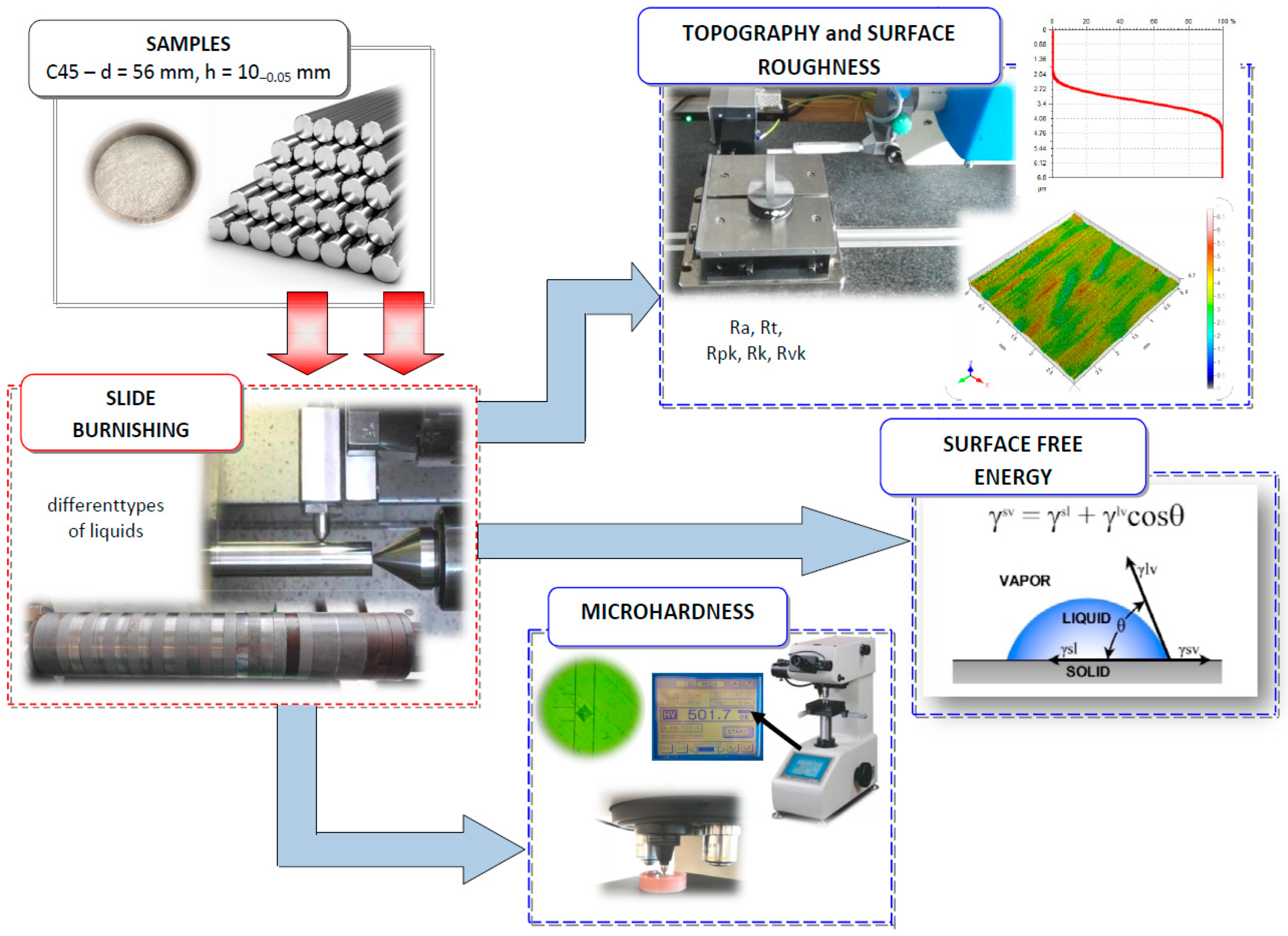
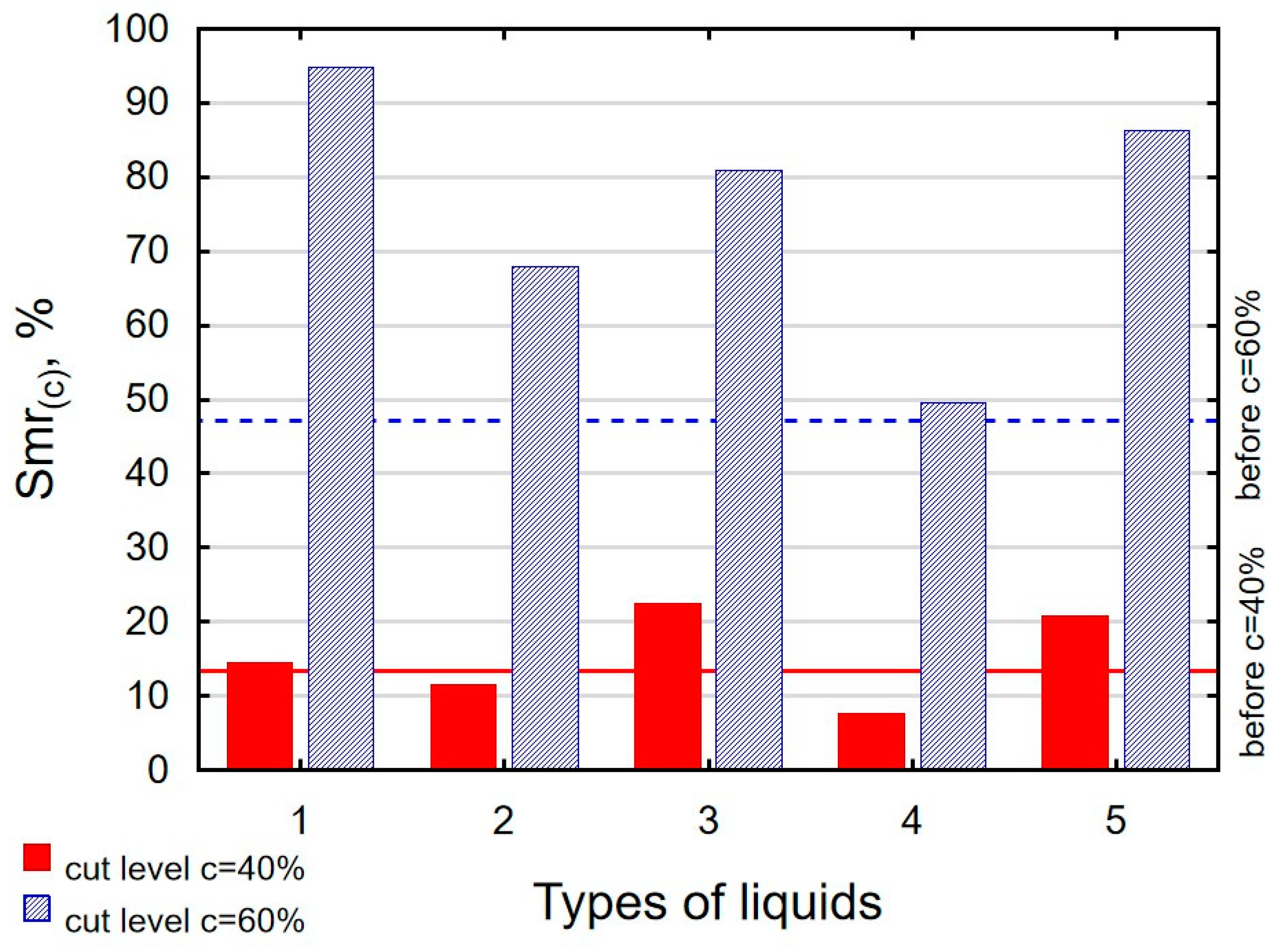
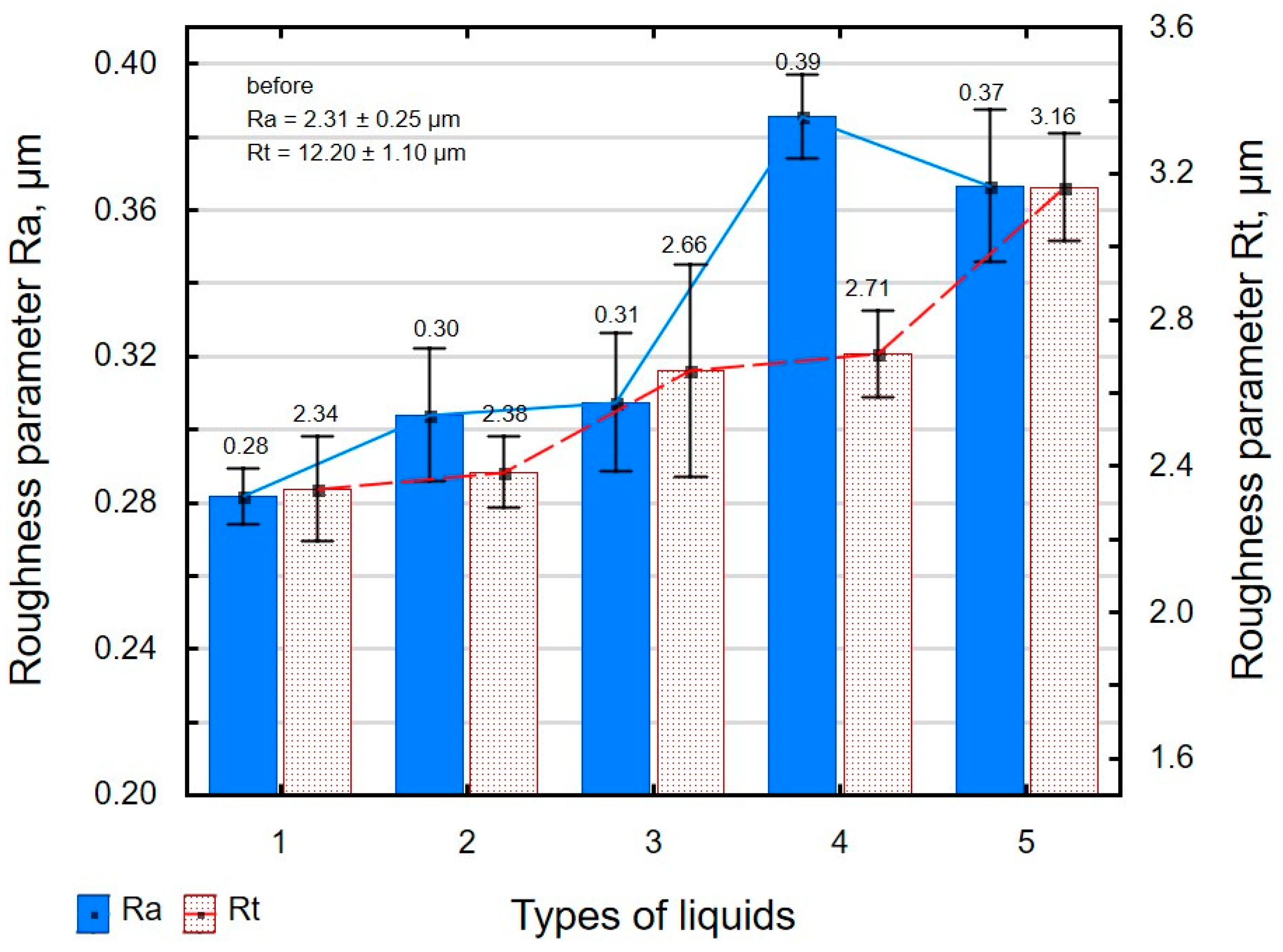

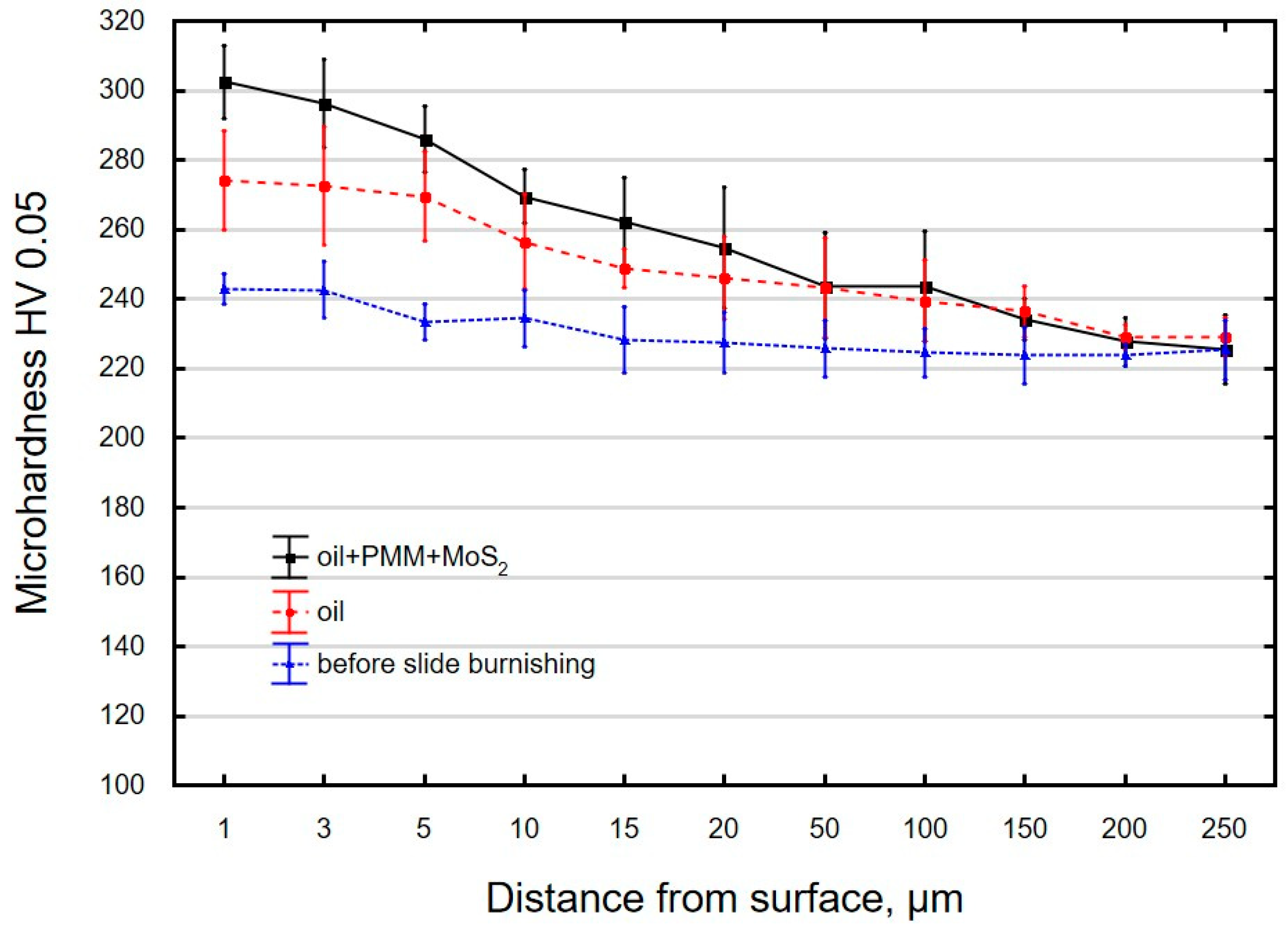
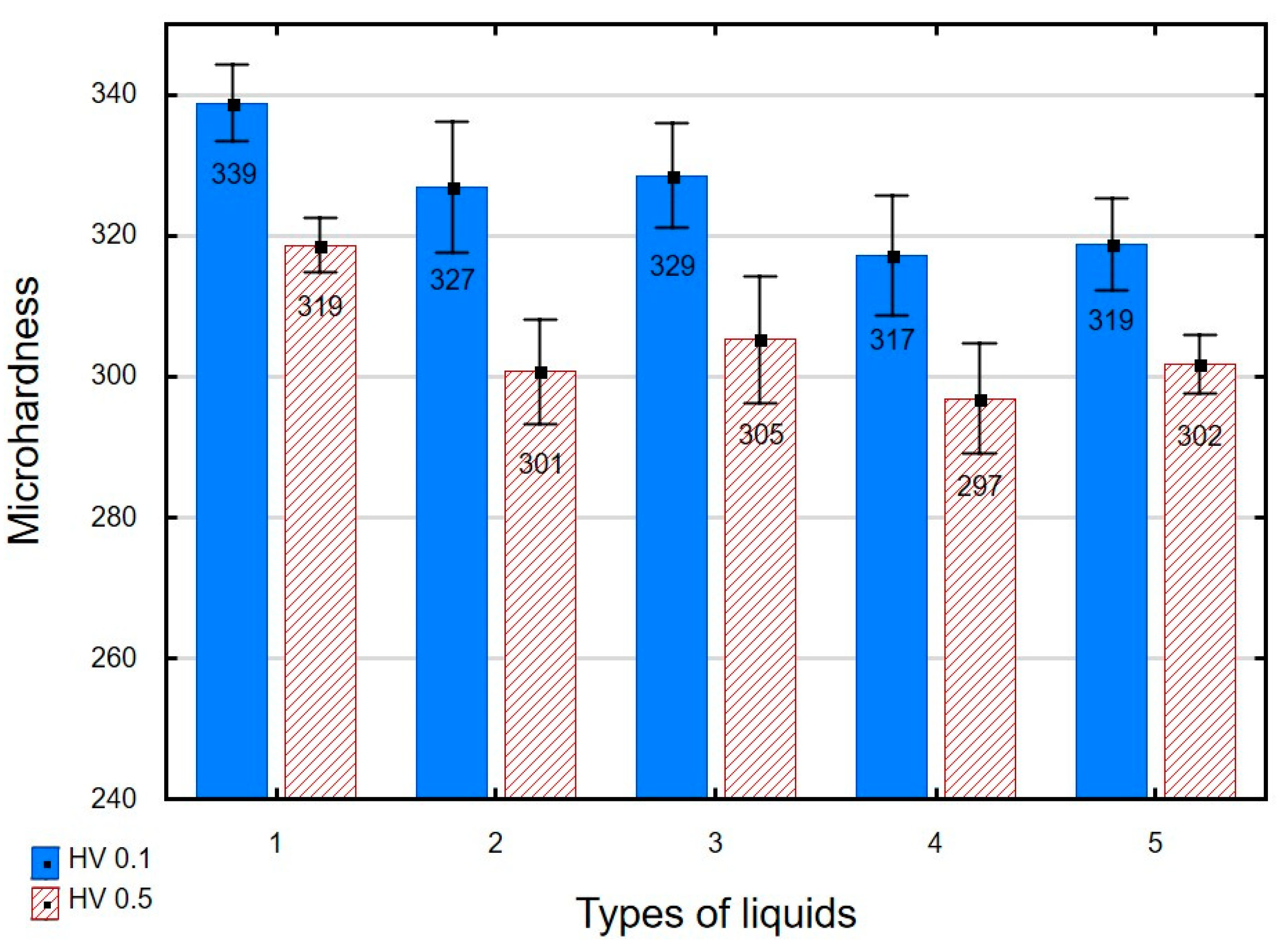
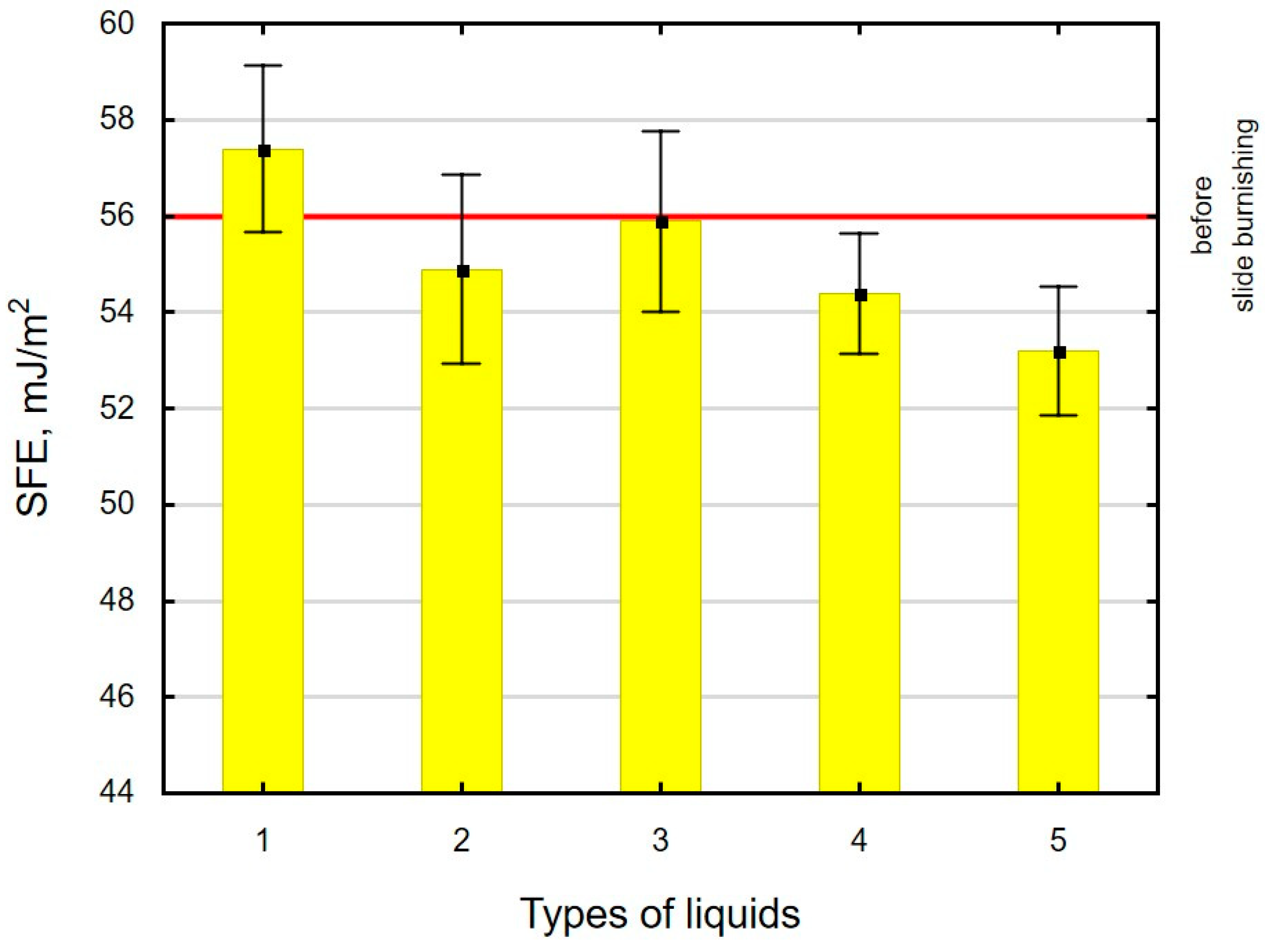
| No. | F, N | f, mm/rev. | v, m/min | Types of Liquid |
|---|---|---|---|---|
| 1 | 180 | 0.04 | 35 | oil with polymethyl methacrylate—PMM (0.5%) and molybdenum disulphide—MoS2 (0.5%) solutions |
| 2 | oil with a polymethyl methacrylate solution—PMM (0.5%) | |||
| 3 | oil with molybdenum disulphide—MoS2(0.5%) | |||
| 4 | Mobile VactraTM Oil No. 2 | |||
| 5 | EcoEm-1 emulsion |
| Pre-Treatment | oil+PMM+MoS2 |
 | 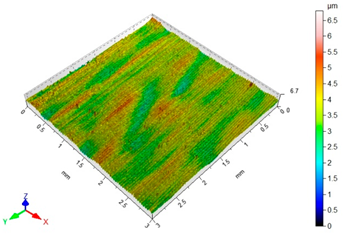 |
| Sa = 1.70 μm, Sz = 15.2 μm, Sp = 8.95 μm, Sv = 6.28 μm, Sku = 2.65, Ssk = 0.564 | Sa = 0.40 μm, Sz = 6.80 μm, Sp = 3.26 μm, Sv = 3.54 μm, Sku = 3.05, Ssk = −0.076 |
| oil+PMM | oil+MoS2 |
 | 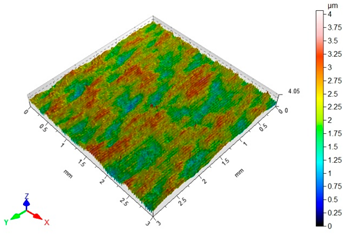 |
| Sa = 0.38 μm, Sz = 5.01 μm, Sp = 2.81 μm, Sv = 2.21 μm, Sku = 3.27, Ssk = −0.059 | Sa = 0.39 μm, Sz = 4.07 μm, Sp = 2.02 μm, Sv = 2.05 μm, Sku = 2.80, Ssk = −0.055 |
| oil | EcoEm-1 emulsion |
 |  |
| Sa = 0.33 μm, Sz = 3.96 μm, Sp = 2.37 μm, Sv = 1.58 μm, Sku = 3.07, Ssk = 0.090 | Sa = 0.43 μm, Sz = 6.61 μm, Sp = 3.40 μm, Sv = 3.22 μm, Sku = 3.45, Ssk = 0.173 |
| Pre-Treatment | oil+PMM+MoS2 |
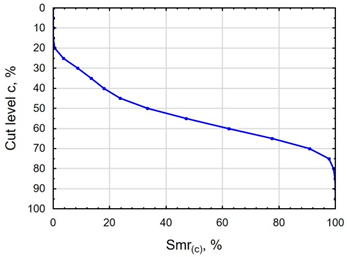 | 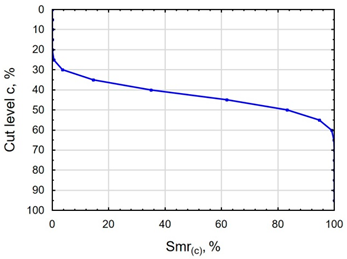 |
| oil+PMM | oil+MoS2 |
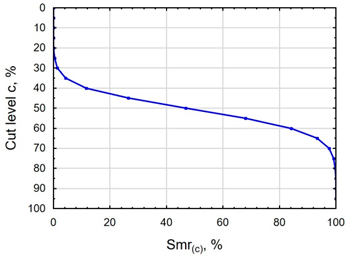 |  |
| oil | EcoEm-1 emulsion |
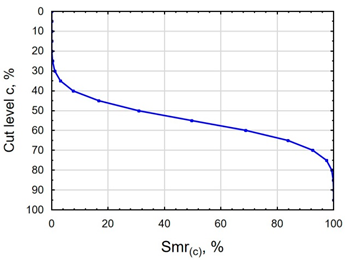 |  |
| Type of Liquid | Measuring Liquid | |
|---|---|---|
| Distilled Water | Diiodomethane | |
| 1 | 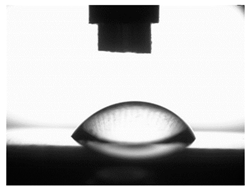 | 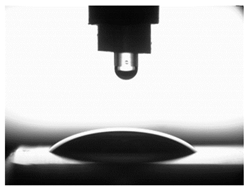 |
| Θ = 66.69° ± 1.51° | Θ = 32.03° ± 1.78° | |
| 2 |  |  |
| Θ = 69.75° ± 2.01° | Θ = 31.91° ± 1.71° | |
| 3 | 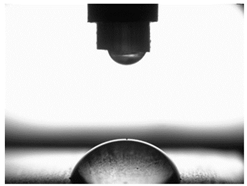 | 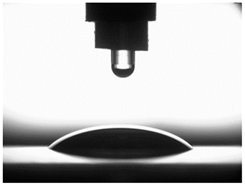 |
| Θ = 70.69° ± 1.56° | Θ = 33.89° ± 2.29° | |
| 4 | 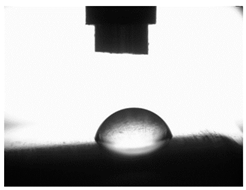 | 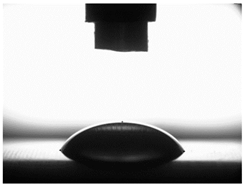 |
| Θ = 71.56° ± 1.67° | Θ = 34.35° ± 1.13° | |
| 5 |  | 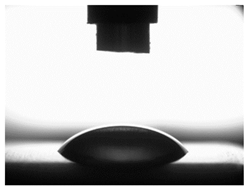 |
| Θ = 75.67° ± 1.73° | Θ = 29.68° ± 1.50° | |
| 6 |  |  |
| Θ = 66.37° ± 3.85° | Θ = 36.68° ± 0.79° | |
Disclaimer/Publisher’s Note: The statements, opinions and data contained in all publications are solely those of the individual author(s) and contributor(s) and not of MDPI and/or the editor(s). MDPI and/or the editor(s) disclaim responsibility for any injury to people or property resulting from any ideas, methods, instructions or products referred to in the content. |
© 2023 by the authors. Licensee MDPI, Basel, Switzerland. This article is an open access article distributed under the terms and conditions of the Creative Commons Attribution (CC BY) license (https://creativecommons.org/licenses/by/4.0/).
Share and Cite
Skoczylas, A.; Kłonica, M. Selected Properties of the Surface Layer of C45 Steel Samples after Slide Burnishing. Materials 2023, 16, 6513. https://doi.org/10.3390/ma16196513
Skoczylas A, Kłonica M. Selected Properties of the Surface Layer of C45 Steel Samples after Slide Burnishing. Materials. 2023; 16(19):6513. https://doi.org/10.3390/ma16196513
Chicago/Turabian StyleSkoczylas, Agnieszka, and Mariusz Kłonica. 2023. "Selected Properties of the Surface Layer of C45 Steel Samples after Slide Burnishing" Materials 16, no. 19: 6513. https://doi.org/10.3390/ma16196513
APA StyleSkoczylas, A., & Kłonica, M. (2023). Selected Properties of the Surface Layer of C45 Steel Samples after Slide Burnishing. Materials, 16(19), 6513. https://doi.org/10.3390/ma16196513









